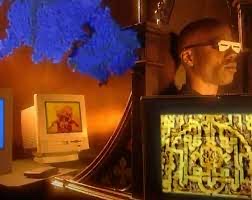
 Home
Home
We will now shift our perspective to the present day and recent decades. This time has been compounded by the development of the World Wide Web, which is sure to change the ways in which we communicate with our fellow humans. The integration of technology with biology incites a liberation from the stifling corporeal. Our technology is once again in a period of great acceleration, in which perhaps we may find a common kinship as communications are able to travel around the globe with increasing speed.
In 1964, Marshal McLuhan proposed, in his seminal work, Understanding Media that technology is an extension of the body. This is finally coming to fruition, as we are increasingly able to transcend the limitations of our forms through technological aids that amplify and distort our bodies. The anonymity of the internet forgoes class barriers and old institutional connections to build a democratic forum where all are able to converse with equally amplified voices. As we approach the turn of the century, what messages might we find in the media that increasingly becomes part of our lives?
When discussing this with a good friend and colleague, Alondra Nelson, she proposed that the internet constitutes "a placeless, raceless, bodiless near-future enabled by technological process". While phsyical land can be colonized, cyberspace remains relatively able to slip through the fingers of those in power. While this could lead to increased radicalization, the ability to connect diasporas across the globe has been widely recognized by the Afro-Futurist movement. Although today's media is multicultural in its casting choices, it still portrays technology as inherently white. Works such as The Last Angel of History re-imagine futurism from a Black subjectivity.
As we learn to communicate with substitutions for the body, it is imperative that this is carried through into our art. Throughout the 20th Century, art has been leaving the walls and plinths of the institution and becoming more and more immersive, encorporating sound, video and performance to create an enhanced viewer experience. Art is no longer a representation of the body. It is the body and its extensions.

The Last Angel of History, Black Audio Film Collective, 1996.
Last year (1996) saw the Black Audio Film Collective's monumental release of the The Last Angel of History. This film follows the adventures of the "data thief" as he weaves the beat of the African drum through space and time, exploring the cultural works of Pan-African artists, including Sun Ra, George Clinton, Samuel R. Delaney and Octavia Butler.
O Superman, Laurie Anderson, 1982
Laurie Anderson brings together avant-garde art with music, using the music video format as a container for performance art. O Superman relates to the devastating technological failure that resulted in the crash of a rescue helicopter in the Iran Hostage Crisis of 1979-1980. The artist used a Vocoder, developed as a coding device in WWII, to record the vocal riff that permeates the track. The song was released on her album Big Science, which achieved popularity throughout the Western world.
The Crossing, Bill Viola, 1996
The Crossing is projected onto a large, double sided projection screen. On one side a man walks from the darkness to be consumed by flame as he approaches the camera, and on the other side, he is submerged in water. As the world becomes globalized, we turn away from dogmatic ways of thinking and towards more spiritual beliefs. In The Crossing, the spiritual merges with the technological and we see new narratives about belief emerge